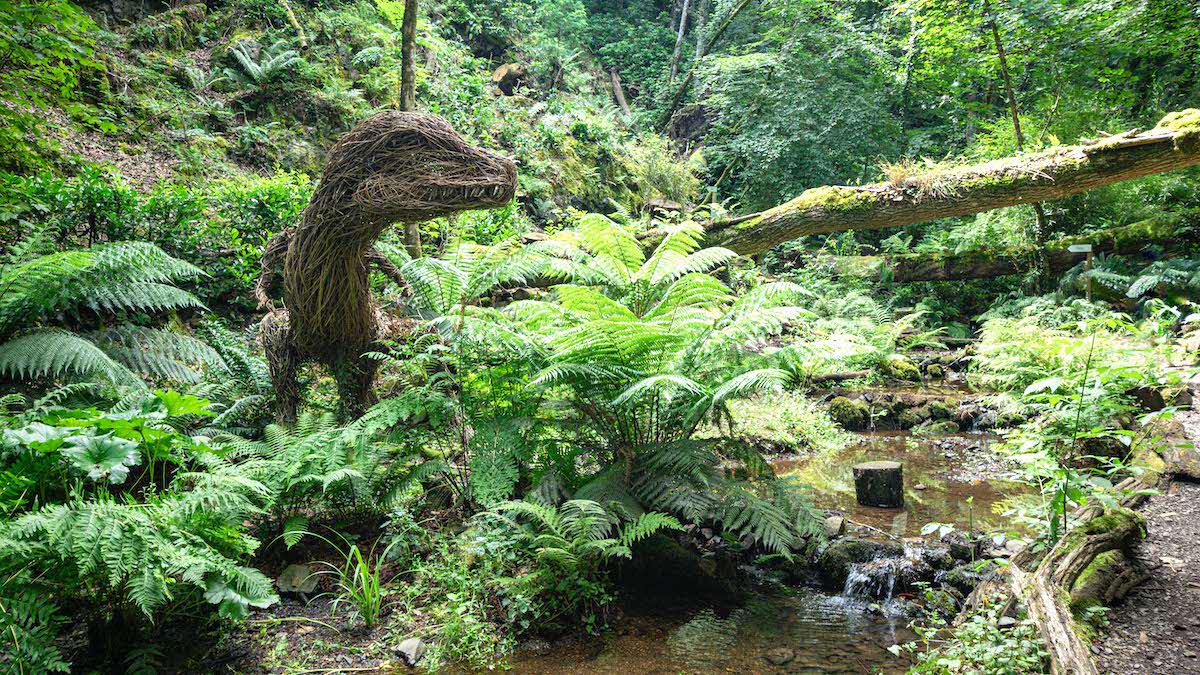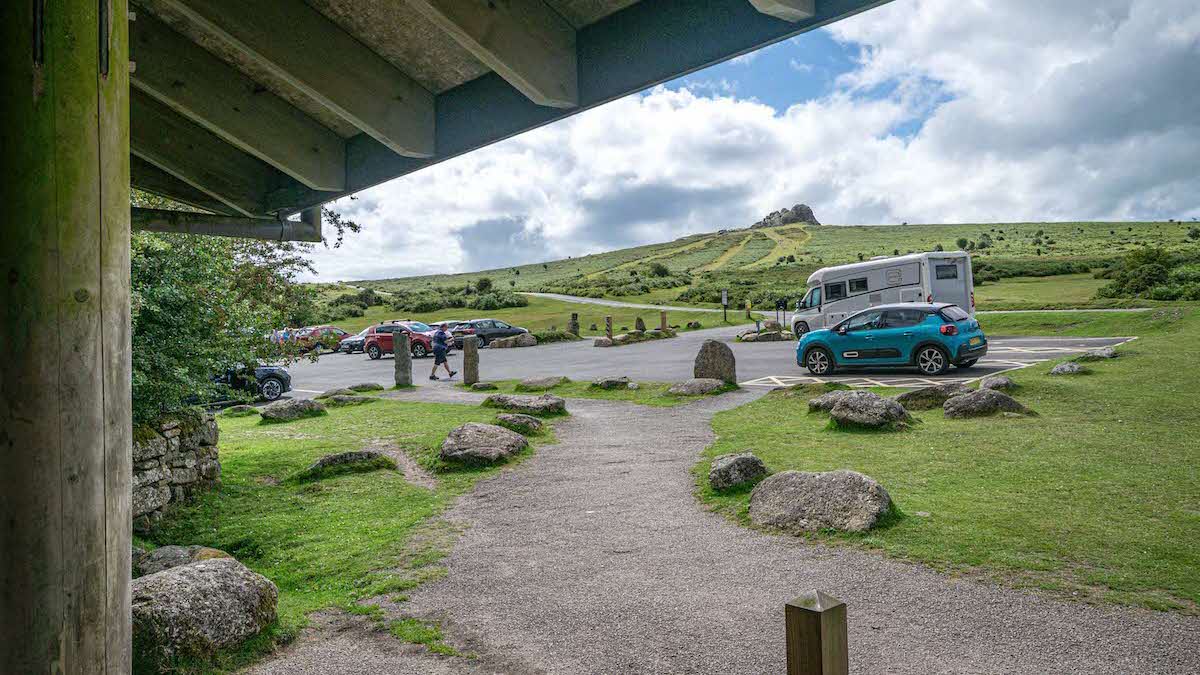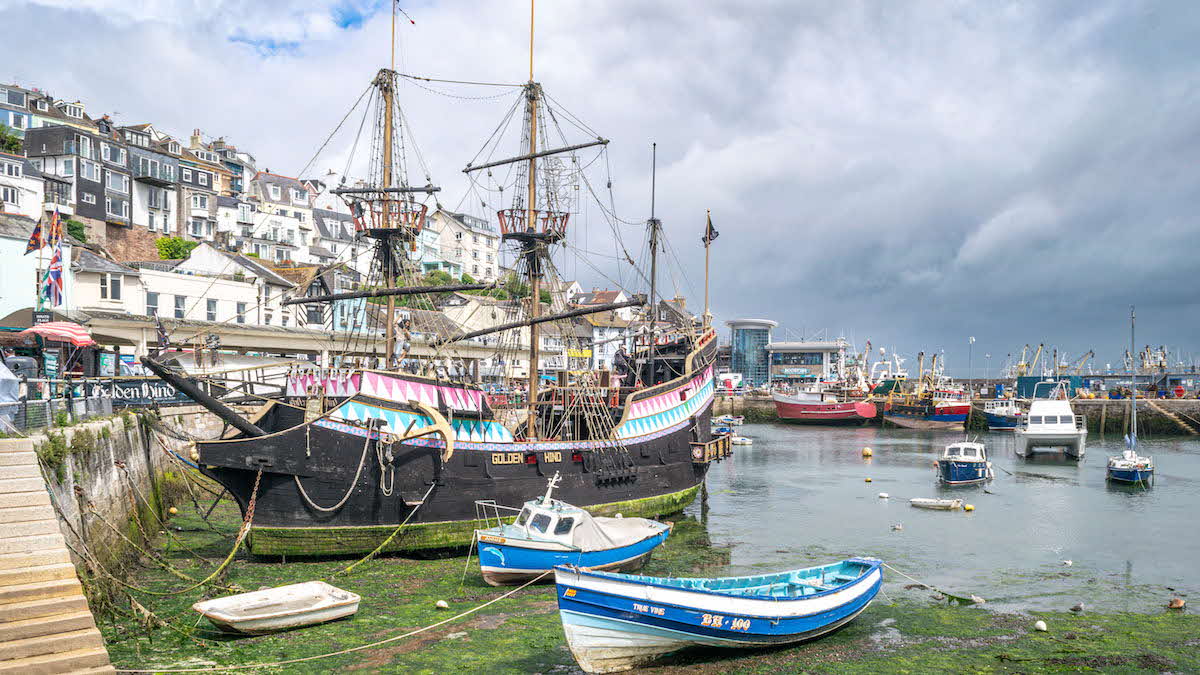Book a Club campsite
Explore hundreds of Club campsites and plan for stays throughout the year. There are plenty of locations to choose from, search and book today.
Book nowDevon-born Aliy Fowler explores her county with a fresh perspective, walking in the footsteps of authors and poets
 Canonteign Falls
Canonteign Falls
I grew up in north Devon so I know the area very well, but when I was a child our family holidays would involve going east into Somerset and Dorset or west into Cornwall. To stay in Devon seemed unadventurous and, consequently, we didn’t see much of the southern part of our own county. This trip offered a long overdue opportunity to put that right, and to explore the area’s rich literary history.
We left Kent at the crack of dawn and journeyed west under grey skies and driving rain – you have to love the British summer! Then, just before noon, as we drew close to the eastern fringe of Dartmoor, the clouds vanished. We found ourselves just a stone’s throw from Canonteign Falls, a private estate where placid lakes sit alongside sunny meadows and ancient woodland. There’s a shaded Victorian fern garden in a mystical hanging valley, home to a woven-willow T-Rex, and a steep wooded path that takes you to the top of south-west England’s highest waterfall, from where the views are stunning. This was the perfect way to stretch our legs before negotiating the remaining four winding miles to our first site.
 National Park Visitor Centre, Haytor, Dartmoor
National Park Visitor Centre, Haytor, Dartmoor
East Dunley is a quiet Certificated Location (CL) right on the edge of the moor. There’s plenty of space, and mature woodland provides shelter for both hardstanding and grass pitches. It’s less than six miles from the National Park Visitor Centre at Haytor and thus ideally placed for a saunter to the eponymous granite outcrop with its spectacular panoramic vistas.
If you fancy a different sort of walk, Stover Country Park is even closer. Here you can follow the Ted Hughes Poetry Trail; designed to celebrate the poet’s long-standing links with Devon, it features 16 ‘poetry posts’ displaying some of his finest nature-inspired works.
The weather was kind, allowing us to enjoy both park and moorland walks, but when the rain finally returned on day two, we headed for House of Marbles in Bovey Tracey. This proved to be a great diversion, incorporating a nostalgic toy and game museum, a studio where you can watch glass-blowers at work, some truly incredible marble runs, plus a restaurant and huge gift shop to boot.
Nine miles south of Bovey Tracey, Dornafield Club Campsite was our second destination. Approaching via a leafy lane, visitors are greeted by the site’s grand 15th-century farmhouse (reputedly besieged in the Civil War by marauding Roundheads). The limestone outbuildings house a shop, games room and information hub, and there’s even a rather splendid lime kiln.
We pitched up and wandered into Ipplepen for a look at St Andrew’s Church, whose Gothic tower can be seen from miles around. In the churchyard, we got chatting to a local resident about our Ted Hughes walk and learned that Ipplepen was also home to a man of letters: Bertram Fletcher Robinson, a prolific writer of short stories and one-time friend of Sherlock Holmes creator Sir Arthur Conan Doyle (Robinson is said to have contributed the bones of the plot for The Hound of the Baskervilles to Conan Doyle).
Nearby Buckfastleigh is dominated by Buckfast Abbey, home to a working community of Benedictine monks. The church and extensive gardens – a veritable haven of peace – are free to visitors and we spent a happy couple of hours exploring. The lavender garden, which boasts 50 varieties of the purple shrub, was an olfactory delight.
 The Golden Hind, Brixham
The Golden Hind, Brixham
Proceeding further south, we arrived at Hillhead Club Campsite in the South Hams. This is a terrific spot, with many of the pitches offering sea views.
Here, we were firmly in Agatha Christie territory as Greenway House, the author’s former holiday home, is only four miles away. The elegant Georgian property, now owned by the National Trust, still steeped in the 1950s, is full of treasures collected on the family’s travels.
The enchanting gardens are surrounded by woodland that sweeps down to the river Dart and there is a quay below the house served by an hourly ferry. This is by far the nicest way to arrive at Greenway. You pass some of the county’s most idyllic scenery en route and get to walk in Poirot’s footsteps as you disembark, for this was the filming location for Dead Man’s Folly in 2013.
In the opposite direction lies the colourful fishing port of Brixham, where life centres around the bustling harbour. We secured a waterside seat at Claws and ordered a couple of their delectable crab sandwiches (we were, after all, on England’s ‘Seafood Coast’).
We spent a lazy hour watching trawlers and day boats toing and froing, then headed inland to explore the narrow streets that lead off the waterfront promenade. Independent shops and cafes proliferate in Middle Street, and there’s an art and craft market by the harbour from Easter to October.
Our next site, Collaton Farm CL, required a short trip on the efficient Kingswear car ferry. Disembarking at Dartmouth, we decided to abandon our vehicle in favour of a wander. The town, famed for its nautical roots, is full of history and culture with a wonderfully eclectic mixture of buildings.
Old Market Square offers a unique range of specialist shops and Foss Street has many interesting boutiques and galleries. It’s also home to the Dartmouth Community Bookshop – a recent incarnation of the famous Harbour Bookshop that was started by Christopher Robin Milne in the 1950s. There is still a ‘Pooh Corner’ here in celebration of this connection.
We had lunch at the excellent Embankment Bistro, then strolled along the river to Dartmouth Castle at the entrance to the estuary. This lovely walk also takes in the 16th-century Bayard’s Cove Fort – once the region’s last line of defence against enemy ships, but now somewhere to watch boats and paddle boarders on the Dart, with the colour-washed houses in Kingswear as the backdrop.
We arrived at Collaton Farm in the late afternoon to a very friendly welcome. It’s a well-cared-for site with pitches facing sublime open countryside, so we felt no compulsion to rush out again! In the morning we took another trip onto the moor, this time bypassing Buckfast and making for Dartmeet. This exceptional beauty spot is where the east and west tributaries of the River Dart intersect.
The attractive, double-arched road bridge dates from 1792 and, about 30 metres upstream, shaded by overhanging trees, is the partially collapsed but still immensely photogenic medieval clapper bridge. It’s a magical place.
 Remains of hill cottages at Foggintor Quarry
Remains of hill cottages at Foggintor Quarry
Plymouth Sound Club Campsite, our fifth stopover, is another elevated site with sensational sea views, and the site staff are a fount of local knowledge. Armed with a list of things to see, we headed first for the oasis of tranquillity that is the Elizabethan Gardens on 16th-century New(!) Street. Despite their situation in the busy Barbican quarter, they are quite tucked away and we were the only visitors.
From there we negotiated the narrow and cobbled Stokes Lane to Quay Road for a stroll around the vibrant harbour. Famous landmarks abound and you’re spoilt for choice with quirky shops and tempting eateries. After a full circuit, we crossed the Sutton Harbour footbridge, seeking the green of Hoe Park and the city’s best-known edifice, Smeaton’s Tower. We braved the lighthouse’s steep ladders and 93 steps to visit the handsomely restored lantern room and enjoy the seascape from 72 feet up.
Continuing west along the top of Plymouth Sound, we ended up at the Waterfront Restaurant. Set in the Grade II listed erstwhile home of the Royal Western Yacht Club, it’s an imposing venue for a meal.
There is a small circular plaque on the eastern side of the building dedicated to Sir Francis Chichester, who departed from Plymouth in his ketch, Gypsy Moth IV, in 1966 for his record-breaking circumnavigation of the globe. Best known as a sailor, Chichester was also a prolific writer. I fondly remember my parents reading us excerpts from his book, Gypsy Moth Circles the World, and marvelling at his descriptions of battling fearsome storms and hostile seas. It is fitting that he should be remembered in this environment.
We drove north next, across the western edge of Dartmoor to the Affiliated Site (AS) at Lydford. The position is fabulous, bordered by rolling green hills and with craggy tors beyond. The call of the moor is too strong to resist here and a good starting point for exploration is the National Park Visitor Centre in Princetown. Formerly the Old Duchy Hotel, Sir Arthur Conan Doyle stayed here when he began writing The Hound of the Baskervilles.
From the Centre, on the B3357 towards Merrivale, you’ll come to the start of a moorland track where there is parking for a few vehicles. This is the route to Foggintor Quarry. After a 20-minute amble down what is actually an old tramway you’ll see the remains of the old workers’ cottages with the ragged outcrop of King’s Tor in the distance. Opposite the ruins is the granite-strewn entrance to the flooded quarry. It’s wild, bewitching and immensely atmospheric. It was used as a location for the 1931 film version of Conan Doyle’s most famous tale, and it’s not hard to see why.
That evening we had a delicious meal in Lydford’s Castle Inn, so called because it’s right next to the tower built by the Earl of Cornwall in the 13th-century. We learnt from another diner that this public house was used in a 1980 version of... well, you can guess which film. There’s no escaping Holmes on Dartmoor!
 Lynmouth Cliff Railway
Lynmouth Cliff Railway
Our final destination took us back to familiar territory for me. The AS at Damage Barton benefits from a magnificent coastal situation, and the pitches and facilities are immaculately maintained. There’s easy access to wide, sandy beaches and you’re just a few miles from the rugged landscape of Exmoor, the setting for R D Blackmore’s novel of passion and adventure, Lorna Doone.
The steep-cut valley of Badgeworthy Water is now referred to as the Doone Valley, being the home of the novel’s outlaws, the Doones. It’s one of the wildest corners of Exmoor with beautiful scenery and abundant wildlife.
Badgeworthy Water feeds into the East Lyn, the river down which snarling hounds pursue their frightened quarry in Henry Williamson’s Tarka the Otter.
We followed Tarka’s route to the pretty coastal village of Lynmouth which, incidentally, was the inspiration for Hollow Bay in James Herbert’s The Secret of Crickley Hall. Part of the plot concerns a catastrophic flood, a real event which devastated Lynmouth in 1952. There is a free permanent exhibition in the little Memorial Hall, which includes a pre-flood model of the village and poignant images of the many buildings that were destroyed.
Opposite the hall is the picturesque harbour with its Germanic Rhenish Tower, thought to have originally stored salt water for indoor bathing.
If you take the road around by the beach, you come to Lynmouth’s best-known attraction, the cliff railway that links it to the town of Lynton 500 feet above. It is the highest and steepest fully water-powered railway in the world. I’d ridden it numerous times as a child, but couldn’t resist another trip. The views it affords across Lynmouth Bay are not to be missed and it made for a glorious ending to our holiday.
This county has such a lot to offer. I’ve always been a champion for my native North Devon, but I can see now that the South is rather special too. We’ll be back!